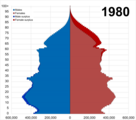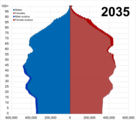
The population of the United Kingdom is getting increasingly older, due to longer life expectancy and a sub-replacement fertility rate for little under 50 years. The society is expected to change as a result culturally and economically. By 2050, 1 in every 4 people is expected to be above the age of 65 and this will be more extreme in certain areas of the country.
Causes


Demographic transition
Further information: Demographic transitionThe UK has undergone the demographic transition of its population, from a pre-industrial population pyramid (1st stage) all the way towards a post-industrial population pyramid (4th stage).
Before the 18th century, the United Kingdom retained an age structure universal to societies in the first stage of the transition theory, with high fertility rates and high mortality rates, in the late 18th century, the Industrial Revolution began, kickstarting the country's transition into the second phase: mortality rates declined but birth rates stayed at the same level; by 1870, the country had begun to transition into the third phase: the birth rate began to decline from around near 5 children per woman to below replacement level in the 1930s. The fourth phase of the transition began in the 1960s, when the fertility rate rose, and peaked during the middle of the decade, and then collapsed by 1973 to a below replacement level rate. Since then, the rate has not risen to an above replacement level fertility rate; this has resulted in a population which is currently ageing: in 2007, for the first time in the country's history, there were more people over the age of 60 then there were under the age of 16.
Fertility
The United Kingdom's fertility rate has, since 1973 (little under 50 years), been in a sub-replacement state. The fertility rate of the country has declined from a peak of a nearly 5 children per woman in late 19th century. By the 1870s, the total fertility rate of the UK population declined from 4.88 children per woman in 1871, to 2.4 by 1921. Traditional means of birth control were used such as abstinence and withdrawal facilitated the collapse of the birth rate, this was also hastened by the 1930s by more modern methods of contraception which were beginning to be used with increased acceptance. For the first time in 1973, the birth rate of the country fell below replacement level, due to liberalising acts of the NHS Reorganisation Act of 1973, the Abortion Act of 1967 and the Divorce Reform Act of 1969.
Population groups
Under 16s
Under 15 year old people currently comprise 19% of the population as of 2019. This group is expected to decline proportionally of the population, they comprised 20.4% in 1999, and are estimated to be 16.9% in 2039.
Working age population
The working age population (usually defined as 16 year old to 64 year old people) currently comprises 62.5% of the population as of 2019. The working age population is also expected to decline proportionally of the population. In 1999, they made up 63.8%, in 2039 they are estimated to make up 59.2%.
Over 65



The over 65 population currently comprises 18.5% of the population as of 2019. In 1999 they comprised one in 6 people (15.8%) and are expected to rise to nearly one every in 4 (23.9%) by 2039. This additionally extends to the over 85s as well, in England alone, the total amount of those over the age of 5 will double from 1.3 million to 2.6 million by 2046.
- Population groups mapped by percentage of total population in local authorities as of the 2021 census
-
 Under 16 year olds
Under 16 year olds
-
 Working age population (16 to 64 years old)
Working age population (16 to 64 years old)
-
 Above 65 years old
Above 65 years old
Implications
Social
Culturally the society is expected to change as a larger proportion of the population comprises the over 65 population and fewer people comprise the under 15 year old population. Social attitudes around old age are expected to change.
Increasingly, more people will begin to live past the age of 100 in future decades. In 2020, there were a total of 15,120 centenarians in the UK.
Economic
Economically, a larger proportion of public spending will need to be devoted to elderly care as the population gets older. Similarly, those over the age of 65 may need to stay in employment, this has been a growing trend since 1998 when around 5% of over 65 year olds were employed to 2018 where just over 10% are still employed. This is a particular problem as currently 30% of the UK's workforce is over the age of 50 in 2015 and due to the lack of young people, there will unlikely be enough people to replace those who leave the workforce due to old age.
NHS general spending is an example of this, with the total cost of a citizen rising as they get older. Due to multi-morbidity which rises with age, the cost of health spending goes up.
Pensions are an additional problem, and are expected to continue to rise as the population gets older. £96.7 billion was paid out in pensions in 2018 alone, with an increase of £1.2 billion from the previous year. Proposed plans to alleviate the problem have been rising the pension age more.
Geographically
Population ageing is more prevalent in those living in rural defined areas than BUAs (built up areas). The cities identified as the youngest were primarily those with a higher proportion of migrant populations. These were: Slough, Oxford, Luton, London, Cambridge, Leicester, Milton Keynes, Coventry, Cardiff, Bradford and Blackburn. In conjunction, cities identified as the oldest in the UK primarily were on the coast, those were: Blackpool, Worthing, Bournemouth, Southend, Swansea, Mansfield, Barnsley, Wakefield, Birkenhead and Sunderland. However the BBC notes that in general, the average age in most cities have grown older.
Government response
The British government has historically been very lax about the issue, in 1984 at the UN Conference on Population in Mexico, the government at the time stated:
The United Kingdom('s) government does not pursue a population policy in the sense of actively trying to influence the overall size of the population, its age-structure, or the components of change except in the field of immigration. Nor has it expressed a view about the size of population, or the age-structure, that would be desirable. ...The current level of births has not been the cause of general anxiety. The prevailing view is that decisions about fertility and childbearing are for people themselves to make, but that it is proper for government to provide individuals with the information and the means necessary to make their decisions effective. To this end, the government provides assistance with family planning as part of the National Health Service. The ‘ageing’ of the population does raise social and economic issues. However, it is believed that these will prove manageable; and also, to a degree, that society will adapt....’
Population pyramids
- Population pyramids of the UK
-
 UK population pyramid from 1950 to 2022
UK population pyramid from 1950 to 2022
-
 England
England
-
 Northern Ireland
Northern Ireland
-
 Scotland
Scotland
-
 Wales
Wales
- Population pyramid, in individual frames
-
 1851
1851
-
 1861
1861
-
 1881
1881
-
 1891
1891
-
 1911
1911
-
 1921
1921
-
 1931
1931
-
 1950
1950
-
 1955
1955
-
 1960
1960
-
 1965
1965
-
 1970
1970
-
 1975
1975
-
 1980
1980
-
 1985
1985
-
 1990
1990
-
 1995
1995
-
 2000
2000
-
 2005
2005
-
 2010
2010
-
 2015
2015
-
 2020
2020
-
 2025
2025
-
 2030
2030
-
 2035
2035
-
 2040
2040
-
 2045
2045
-
 2050
2050
-
 2055
2055
-
 2060
2060
-
 2065
2065
-
 2070
2070
-
 2075
2075
-
 2080
2080
-
 2085
2085
-
 2090
2090
-
 2095
2095
-
 2100
2100
References
- ^ "Overview of the UK population - Office for National Statistics". www.ons.gov.uk. Retrieved 2022-12-05.
- ^ "Living longer - Office for National Statistics". www.ons.gov.uk. Retrieved 2022-12-05.
- ^ Chappell, Roma, ed. (2005). "Chapter 1: The UK population past, present and future.". Focus On People and Migration. Palgrave Macmillan London. doi:10.1007/978-1-349-75096-2. ISBN 978-1-4039-9327-4.
- Stockdale, Aileen (May 2011). "A review of demographic ageing in the UK: opportunities for rural research: A Review of Demographic Ageing in the UK". Population, Space and Place. 17 (3): 204–221. doi:10.1002/psp.591.
- "UK ageing population". 21st Century Challenges. 2015-06-15. Retrieved 2022-12-20.
- ^ Klusener, Edgar (2019-06-05). "How big an issue is the UK's ageing population?". Global Social Challenges. Retrieved 2022-12-20.
- Sigle, Wendy (2016), Rindfuss, Ronald R.; Choe, Minja Kim (eds.), "Fertility and Population Change in the United Kingdom", Low Fertility, Institutions, and their Policies: Variations Across Industrialized Countries, Cham: Springer International Publishing, pp. 77–98, doi:10.1007/978-3-319-32997-0_4, ISBN 978-3-319-32997-0, retrieved 2022-05-31
- Team, Editorial (2018-08-15). "The ageing workforce: you can teach an old dog new tricks". HR News. Retrieved 2022-12-20.
- "Millions in Britain at risk of poor-quality later life, report says". the Guardian. 2019-03-13. Retrieved 2022-12-20.
- "Our ageing population - The Health Foundation". www.health.org.uk. Retrieved 2022-12-20.
- "Old age: Why 70 may be the new 65". BBC News. 2019-11-19. Retrieved 2022-12-20.
- "Future of an ageing population". GOV.UK. 11 July 2019. Retrieved 2022-12-20.
- Gray, Muir (2015-03-31). "Sod 70! I hate being one of 'the elderly' but not for the reasons you may think". the Guardian. Retrieved 2022-12-20.
- "2022 ageing & older population statistics | Age Co Mobility". www.ageukmobility.co.uk. Retrieved 2022-12-20.
- "Workforce Demographics UK | Reports". CIPD. Retrieved 2022-12-20.
- "Britain's ageing population could boost economic growth – if we adapt". CityAM. 2015-06-25. Retrieved 2022-12-20.
- "Ageing and health expenditure - UK Health Security Agency". ukhsa.blog.gov.uk. 29 January 2019. Retrieved 2022-12-20.
- "A growing - and ageing - nation". 2006-08-27. Retrieved 2022-12-20.
- Read, John (2015-03-18). "How will future governments fund retired workers?". the Guardian. Retrieved 2022-12-20.
- Bates, Isabelle (2022-11-26). "Pension age could rise to 68 to save 'billions' of pounds". BirminghamLive. Retrieved 2022-12-20.
- "2011 rural/urban classification - Office for National Statistics". www.ons.gov.uk. Retrieved 2022-12-06.
- ^ "Where are the UK's youngest and oldest city populations?". BBC News. 2018-03-19. Retrieved 2022-12-20.
- Sigle, Wendy (2016), Rindfuss, Ronald R.; Choe, Minja Kim (eds.), "Fertility and Population Change in the United Kingdom", Low Fertility, Institutions, and their Policies: Variations Across Industrialized Countries, Cham: Springer International Publishing, pp. 77–98, doi:10.1007/978-3-319-32997-0_4, ISBN 978-3-319-32997-0, retrieved 2022-05-31
| Population ageing | |
|---|---|
| Population ageing in Asia | |
| Population ageing in Europe | |
| Population ageing in North America | |
| Population ageing in Oceania | |
| Population ageing by continent | |
| Related articles | |
| Ageing of Europe | |
|---|---|
| Sovereign states |
|
| States with limited recognition | |
| Dependencies and other entities | |